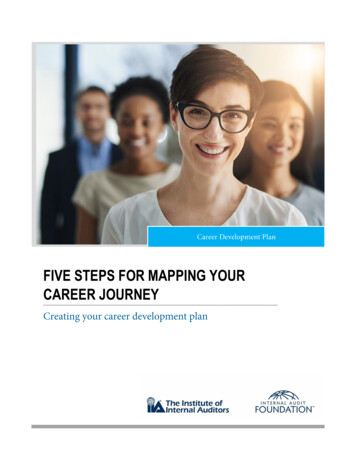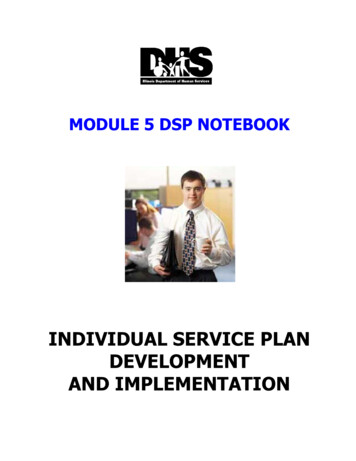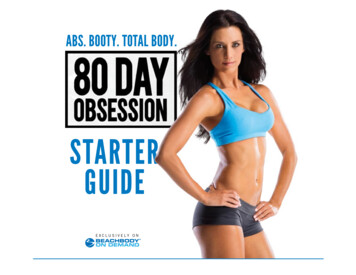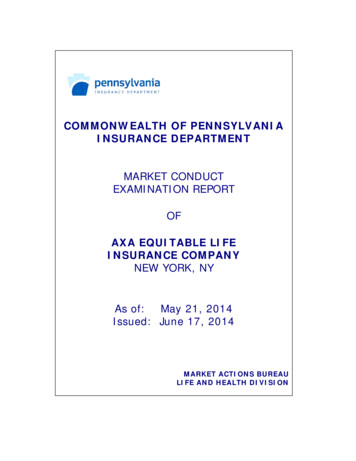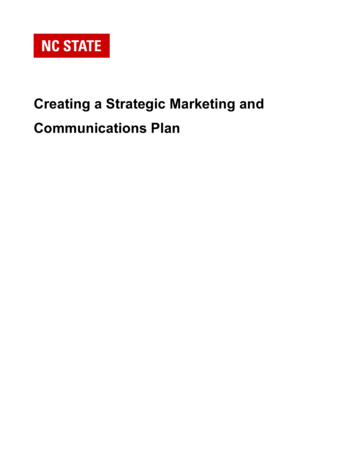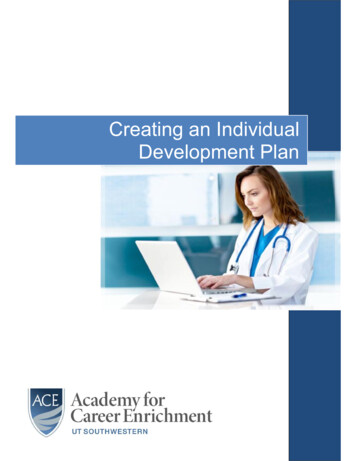
Transcription
Creating an IndividualDevelopment Plan
ContentsDeveloping Insight.3Motivation.9Capability.10Real-World Practice.11Accountability.12Bringing It All Together .13Individual Development PlanUT Southwestern Medical Center1
IntroductionCreating an Individual Development Plan (IDP) can be a daunting task. Knowingwhere to start, or even what to look at in terms of development can be confusing.To assist you with your creation of an IDP we have developed this toolkit. There aretwo main benefits of using this document:1. It will give you a step-by-step process for building an IDP2. It will simplify what can be overwhelming2
Developing InsightThe first step in developing an Individual Development Plan (IDP) is to gain insightabout your current strengths and areas of development. There are several sourcesfrom which you can gain insight: the UT Southwestern Leadership Model, peers,stakeholders, and your direct manager. Additionally, you will want to think aboutyour current role versus future role. What skills or behaviors will need to bedeveloped in order to meet the needs of your desired future role?UT Southwestern Leadership ModelA place to begin your IDP is to consider the UT Southwestern Leadership Model. Ifyou are unfamiliar with the model, please take a few minutes now and review it. TheUT Southwestern Leadership Model is divided into twelve leadership competenciesspecific to levels of the organization, which are Individual Contributor, Mid-LevelLeader/Professional Individual Contributor, and Executive Leader. You areencouraged to review the model as a whole, and then focus in on the key actionsexpected of your level and your desired level within the organization.3
4
5
6
Current versus Future RoleIn addition to looking at the UT Southwestern Leadership Model, you may also wantto consider what behaviors and skills will be required to remain successful in yourcurrent role as well as any future role(s) to which you aspire. You may want to gaininsight from those in roles you aspire to as a way to discover what behaviors andskill sets are required. If your goal is to remain in your current role, you will want toconsider what skills and behaviors may be needed to remain relevant and up-todate.Current Role Needs:Future Role Needs:7
Insight from OthersAnother excellent place to look for insight is to talk to your peers, your stakeholders,and your direct manager. Knowing what it is they think you do well, and where youcould develop or improve, is very important for focusing on what you may want todevelop.My peers say my strengths are:My peers say I could develop in:My stakeholders say my strengths are: My stakeholders say I could developin:My manager says my strengths are:My manager says I could develop in:8
MotivationTo devote the time and effort required to make progress on a developmental area,you have to WANT it! You cannot be lukewarm on a development activity and give itthe time and attention it deserves. We encourage you to consider the strengths andareas you are considering for development, and then realistically rate your level ofmotivation about each one.On a scale of 1 to 5 with 1 being not at all interested in developing, and 5 beingenthusiastic about developing, rate your excitement level about your areas ofdevelopment.Developmental AreaRating9
CapabilityEarlier we asked you to think about the future role you aspire to attain in theorganization. We then asked you to think about both your current responsibilitiesand the future responsibilities of the desired role. Based on the differences, whatareas will you need to strengthen and develop to be able to do those newresponsibilities? Here is a place to capture those thoughts.Current ResponsibilitiesAreas of Strength andDevelopment Needed toMeet Future GoalsFuture Responsibilities10
Real-World PracticeEducation (10%)Exposure (20%)Experience (70%)Now that you have gained insight, looked at your motivation and your capabilities,you will want to begin considering various activities you can use for development.As you begin thinking about these, you will want to keep the 70/20/10 model in mind.This means that 70% of your activities will be on-the-job experiences; 20% will beexposure to key individuals, leaders, and teams as well as through feedback,coaching, and being mentored; 10% will be formal education, which could includeattending training courses or reading books, articles, work-related blogs, and otherliterature that will create learning. For access to books, articles, and online trainingvisit .The real world experience will be driven by the areas you select to place on yourIDP. You may want to list activities in each of the categories below.11
AccountabilityOnce you have selected the activities you want to include in your IDP, you will wantto consider the accountability measures you will put in place to keep you on track.Think of this like a walking buddy who helps keep you motivated and accountable.This can include information such as when it will be completed, quality standards, orany other measurement components you feel are necessary. To prepare your IDP,you can record your activities and ideas for measurement below. Remember, this isa development plan, not a performance plan, so you want to put activities in herethat will stretch you, but that are also attainable. Nothing kills motivation to developquicker than an unrealistic goal or activity.Development ActivityMeasurement12
Bringing It All TogetherNow that you’ve gained insight as to your strengths and opportunities, looked at yourmotivations and capabilities, thought about real world practice and measurement, itis now time to bring it all together into an Individual Development Plan. Taking all ofthe data you’ve collected, please fill out the template on the next page, which you willwant to use in your discussion with your immediate manager.13
Individual Development PlanName:Date:Professional Goals (1-2 years) Professional Goals (3-5 years)Strength To Use MoreDevelopmentActivityArea Of DevelopmentMeasurementResults14
Career Development ProgramReading ListCareer Development and Planning: A Comprehensive Approachby Robert C. ReardonCareer Development for Health Professionals: Success in School and on the Jobby Lee HarounCareer Development Interventions in the 21st Centuryby Spencer G. NilesDo What You Love, The Money Will Follow: Discovering Your Right Livelihoodby Marsha SinetarDon’t Stop the Career Clock: Rejecting the Myths of Aging for a New Way to Work in the 21st Centuryby Helen Harkness, Ph.D.Let Your Life Speak: Listening for the Voice of Vocationby Parker J. PalmerNow, Discover Your Strengthsby Don Clifton and Marcus BuckinghamThe Career Chase: Taking Creative Control in a Chaotic Ageby Helen Harkness, Ph.D.The 5 Patterns of Extraordinary Careers: The Guide for Achieving Success and Satisfactionby James M. Citrin and Richard A. SmithThe Path: Creating Your Mission Statement for Work and Lifeby Laurie Beth JonesWhat Color is Your Parachute?by Richard N. Bolles and Mark Emery BollesWhat Should I Do With My Life? The Real Meaning of Success and How to Find Itby Po BransonWho Gets Promoted, Who Doesn’t, and Why: 10 Things You’d Better Do if You Want to Get Aheadby Donald AsherWorking Identity: Unconventional Strategies for Reinventing Your Careerby Herminia Ibarra
The University of Texas System Employee Advisory CouncilCareer Development CommitteeWebsite ResourcesGallup- ployeeengagement.aspxWith proven links to productivity, customer engagement, quality, retention, safety, and profit, Gallup'sunique employee engagement approach blends strategic analysis with practical steps and advice tochange how leaders view their work, their employees, and their customers.Society for Human Resource dev/pages/default.aspxSociety for Human Resource Management (SHRM) is the world’s largest HR membership organizationdevoted to human resource management.Linked In- https://www.linkedin.com/about-us?trk hb ft aboutThe world's largest professional network with 300 million members in over 200 countries and territoriesaround the globe. Their mission is simple: connect the world's professionals to make them moreproductive and successful. When you join LinkedIn, you get access to people, jobs, news, updates, andinsights that help you be great at what you do.
Last edited 12/10/14Workforce Satisfaction CommitteeManager’s PerspectiveThis is a synopsis of some of the attributes which managers desire in their employees. This is not allinclusive because it can be applied to many different types of jobs.1. Job Knowledge: The degree of familiarity with job procedures and equipment that is essential tosatisfactory job performance. Accuracy, attention to detail, and orderliness. The ability to meetor surpass established goals and use of time during the workday.2. Trustworthiness: Carrying moral and ethical value and exhibiting this through actions at theworkplace. Trust can be built by meeting expectations consistently over time and exhibitingintegrity.3. Dependability: The amount of supervision necessary to carry out assigned tasks to completion inorder to meet job goals.4. Initiative & Creativity: Ability to be innovative, talent for having new ideas, and for finding newand better ways of doing things, as well as being imaginative.5. Continual Learning: The degree to which the employee is increasing their contribution to thedepartment, and to their institution as a whole. This would include learning new skills and takingadvantage of opportunities to make themselves more valuable to the institution.6. Cooperation: Interpersonal relations, or the extent to which the employee recognizes the needsand desires of other people, treats others with respect and courtesy, and inspires their respectand confidence.7. Customer Service: The degree to which the employee follows through with assisting others.Providing exceptional customer service applies not only to employees who deal with clients,patients, or students, but also to employees who interact with coworkers, managers, and otherstakeholders. It should be exhibited to everyone he or she interacts with.Sources:The content here was derived from the UT Tyler Performance Evaluation as well as various pages onSHRM’s (Society of Human Resource Management) website at www.shrm.org.
UT Brownsville,About 250 full time employees were riftedUT Brownsville offered many services to those employees who were affected by this change Benefits offered Monetary compensation depending on years of service to the institution if stayedemployed in good standards until May 31, 2013. Lab was exclusively set up (computer and phone line) for rifted employees to come andprepare for a new job search. Open from 8-5 every day. Apply to NextJob ( Job search engine with resume and cover letter services to betterprepare the employee on a successful job search. Seminars, Health and wellness classes were available for employees to attend andparticipate Employees were also given the opportunity to stay in their positions until the end oftheir assignment, 8/31/2013 or move full time to the Employee Development Centeruntil the reminder of their assignment, 8/31/2013.Employees Rifted and ReHiredIncentives Benefits were not interrupted, continuation of vacation hours were carried over Draw downsWorkload doubled for many positions that were newly created or positions that weremerged because of rifted employee vacanciesSignificant salary dropNo deadline provided for new re-structured positionsStressful working conditionsNo professional development providedSince a probationary period needs to again be completed, rehired employee cannotparticipate in the exceptional award merit. Employee will have to complete a 3-4 monthperformance review in new position with new supervisor.Recommendations Evaluation of re-structured positions and newly created areas be done for best practice Consider re-hired employees be considered for exceptional merit reward as well(reason: all re-hired employees were UTB rifted employees non outside or new personswere allowed to apply for these positions) Re-classification of positions after an evaluation completed Professional Development be encouraged and offered to those re-hired employees whoscore a high evaluation number in the Annual Employee Performance. Incentives to wellness or fees be waived to campus recreational centers be
stakeholders, and your direct manager. Additionally, you will want to think about your current role versus future role. What skills or behaviors will need to be developed in order to meet the needs of your desired future role? UT Southwestern Leadership Model A place to begin your IDP is to consider the UT Southwestern Leadership Model. If


